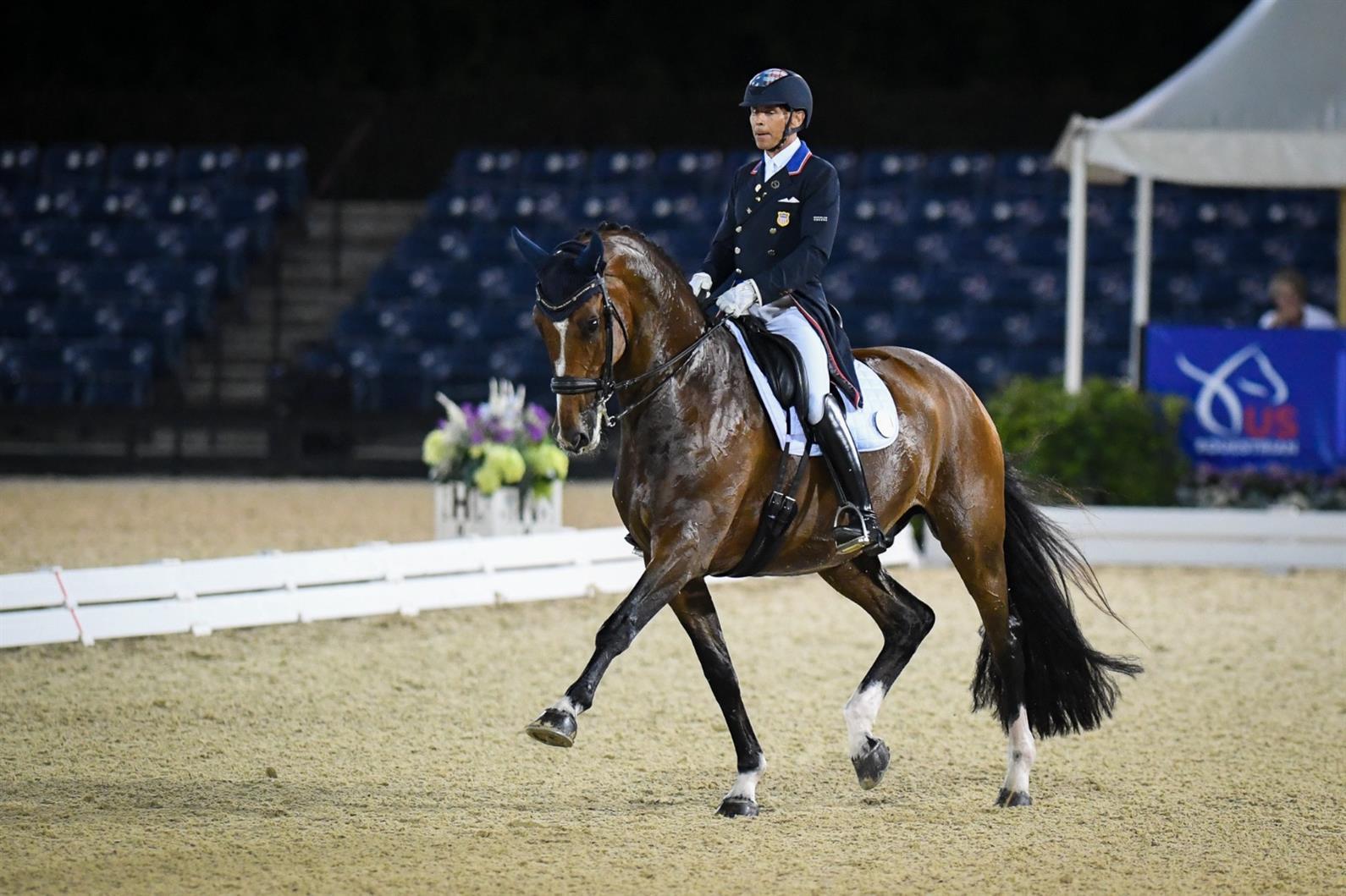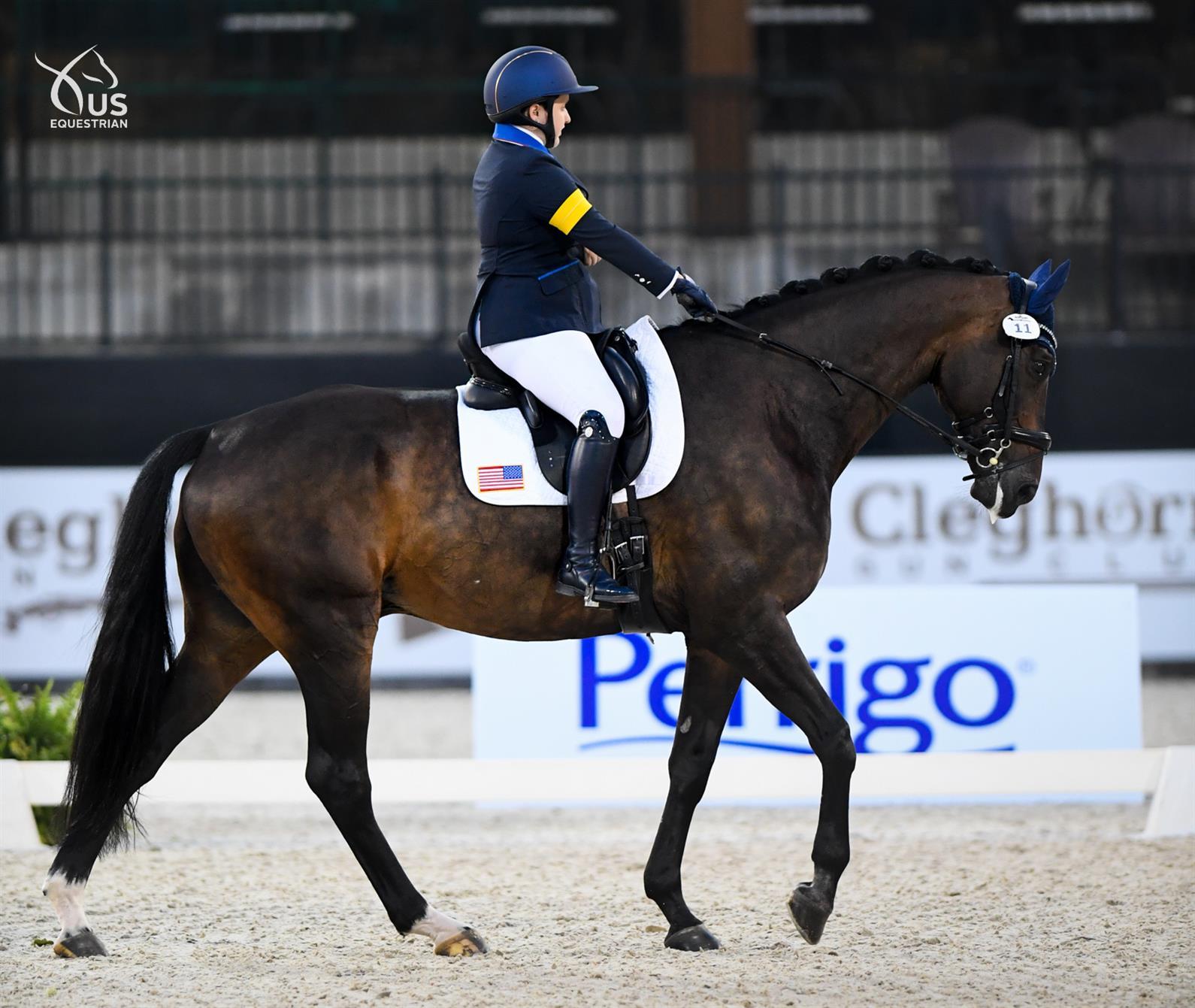For fans of dressage, the musical freestyle is a highlight of any competition. Even spectators unfamiliar with the intricacies of the sport can appreciate a good freestyle to music, as evidenced by the mainstream reach of U.S. dressage athlete Steffen Peters’ ride with Suppenkasper (barn name Mopsie) at the Tokyo 2020 Olympics.
When executed well, the music behind a freestyle highlights the horse’s rhythm and movement while enhancing the dance-like quality of a dressage test. Creating the right soundtrack is a fun but complex task. Peters, now a five-time Olympian known for fun musical freestyles, and Sydney Collier, a member of the 2016 U.S. Para Dressage Team at the Rio Paralympics, shared their insights about creating a musical freestyle.
“Alex, come look at this rave horse!”
Peters has brought popular music into the dressage arena for years, utilizing tunes by Pink Floyd, The Rolling Stones, and even Vanilla Ice, among others. But the freestyle he brought to the Tokyo Olympics, which included retro pop and electronic dance music, might be his most famous yet, thanks to a viral (since removed) video by TikToker @gaaydhd, who coined the “Rave Horse” moniker, declared dressage her new favorite sport, and launched countless shares across social media platforms.
Watch Steffen Peters and Mopsie react to the "Rave Horse" TikTok here.
“The way I look at it, I didn’t go viral. Mopsie did,” says Peters. “Honestly, I like it this way much better that my name isn’t being mentioned that much, but Mopsie’s name is mentioned a lot.”
It may be Mopsie’s moves that get the likes, but Peters gets much of the credit for the soundtrack.
“I know exactly how many beats per minute Mopsie has at trot and passage and in canter,” he explains. “I thought that we needed to find a little bit better trot music for Mopsie. We had music for the canter, the walk, the passage, but the trot music was just not quite right.”
Peters enjoys listening to music, and one day he came across a modified version of Haddaway’s “What Is Love?”
“That’s basically when it clicked,” he said. “When you listen to music in headphones, everything can sound very dynamic, exciting. But when you play it in the open, in a stadium that maybe doesn’t have the best audio system, sometimes that dynamic feeling gets lost. So I played it over the speakers and the people who were watching said, ‘Yep, that’s it.’ People were reminded of the 80s, and the decision was made to have that piece and combine it with ‘Destination Calabria.’ It’s very happy, upbeat music. It’s the music that, if I walk into a club, it would probably get me on the dance floor.”

Peters works with audio producers who put the music together and tweak it to fit the choreography. From there, his job is to perfect the dressage aspect.
“I don’t do the full freestyle [when practicing at home],” says Peters. “But I know exactly where I need to be, where the walk music starts, where the canter music starts, where the trot is. So I do sections and then try to nail not just Mopsie’s footfall matching the beat of the music, but I still want to be able to ride my corners so it doesn’t look like I’m using the arena just to match the music. I still want to ride a real, proper corner, and make sure the arena is used properly.”
Over the years, Peters has incorporated some of his favorite music in multiple freestyles. Longtime fans may remember that Men Without Hats’ “Safety Dance” featured prominently in Peters freestyle with Ravel at the 2010 WEG. The tune makes a brief appearance in his current freestyle with Mopsie.
“Safety Dance was one of my favorite pieces of music in the 80s—my teenage years,” says Peters. “It was a great time in my life. [The song] reminds me of some incredible friends that I still have in Germany, and they get a kick out of it any time they hear it. So that’s a lot of good memories and a lot of gratitude.”
The music undoubtedly enhances the spectator experience of dressage, and as a rider, Peters can choose music that he enjoys listening to. But does the Rave Horse himself also enjoy the upbeat score?
“I tend to ride the passage too forward, and that doesn’t work with Mopsie,” Peters explains. “I have to keep the passage very small in a certain tempo, and when I hear the music, Mopsie seems to adjust to that shorter tempo in the freestyle a little bit easier than in the Grand Prix and the Grand Prix Special. So, do horses feel the music? I can’t quite tell you that. All I know is that the passage in our freestyle is usually better.”
Peters plans to keep improving on his current freestyle with the potential of performing it for a home-country crowd at the 2023 FEI Dressage World Cup™ Final, which will be held in Omaha, Nebraska.
“I’ve had freestyles that were a bit more dramatic; I had one written to the music of Avatar, and that worked quite well in Europe where dressage fans are a bit more reserved and like to listen to the more dramatic, emotional music,” says Peters. “But for me, in the U.S., the freestyle needs to be a party. Usually the crowds are wonderful. The fans in the U.S. enjoy a good party tune.”
Storytelling through Music and Movement
A freestyle can be a party, but it can also tell a story. That’s how para dressage athlete Sydney Collier describes the freestyle she performs with All In One, better known as Alle, Going For Gold LLC and Katie Robicheaux’s 2009 Hanoverian gelding who she’s ridden and competed with since 2019.

“Currently I have my favorite freestyle ever, and the music is from ‘Kung Fu Panda’,” Collier says. “What I really love about it is that it tells the story of Alle’s and my journey: all of the ups and downs through my medical stuff. It tells the story through the movements and through the coordination of the music.”
Collier’s freestyle was designed and choreographed by Marlene Whitaker, and it was Whitaker who suggested the “Kung Fu Panda” score. After that suggestion, Collier rewatched the movie to get a better sense of the music.
“The movie is about a panda learning to do kung fu, right? And having to learn from a sensei how to do it and how to be successful at something that he might not traditionally be thought of as doing, and going up against these greats,” she says. “It really resonated with me when I rewatched the movie and heard that music and thought, ‘Wow, it is my story’—the learning aspect of it, and having great teachers throughout your life who mold you into who you are.”
Collier competes in Grade I, which is a walk-only test. Precision is essential for success with the subtle transitions and changes of movement in the grade.
“[Whitaker] puts in so many awesome, subtle cues that you don’t notice from the outside,” says Collier. “But if you’re me or my trainer, you know right where those cues are, and it makes it so that you can tactfully ride the freestyle. I think that’s something that people might not know to appreciate, because dressage riders make it look so effortless, flowing with their music. But there’s so much multi-tasking involved in riding a freestyle. You have to be so present in the moment with your horse and also be so present in the moment with your music, and it takes the multitasking of riding a traditional test to just a whole new level.”
In the process of selecting her music, Collier rode Alle to samples of music that Whitaker sent for consideration.
“It’s funny because you wouldn’t really anticipate it, but the horses are very opinionated about what they like and what they don’t,” says Collier. “There’s some music that they just don’t flow correctly to, and that’s pretty much how you know, no, they don’t like that music. It doesn’t really click.
“This music just really clicked with Alle,” she continues. “Over the course of our career together, he and I have grown a lot and developed over that time and the music has had to be reworked, tempo-wise. The music has to grow with you. Thankfully Alle and I have Marlene Whitaker who has been there every step of the way with us, really helping us fine-tune our music, and most importantly, that he and I have the most understanding of the music as possible.”
In creating the freestyle, the first step for Collier was to work with her trainer, Katie Robicheaux, to put in the required elements for the test and put them together in a way that’s going to maximize the horse-and-rider pair’s strengths.
“With para dressage, it’s best to keep it kind of simple and stick to the things that are going to get you the best marks and not throw in a bunch of frivolous stuff,” Collier says. “Once we had a basic ground plan, we videoed it and Marlene went to the drawing board with our music.”
From there, Marlene tunes the choreography and adds the subtle markers to the music that help the rider know where they need to be in their test.
“They’re really subtle markers that will let me know if I’m starting a movement too early or too late,” Collier says. “You have to really know how to listen to it so that [spectators] can’t really tell.”
Collier and Alle practice at home with the music at least once a month. “Even when I’m not practicing it on the horse, I’ll practice it on my mobility scooter,” she says. “I’m out there on the driveway riding through it on my mobility scooter to keep it fresh in my mind. For able-bodied riders, the equivalent might be to walk it out and just really get familiar with your music when you’re not on the horse. Especially in the beginning, that ability to really know it when you’re off the horse helps for it to click better when you’re on.”
Alle has opinions on his soundtrack, according to Collier. His reaction to test music has been an essential part of selecting the right pieces.
“For para dressage, in the team test, we’re allowed to have background music to complement our horse. Right before we went to Aachen, we were deciding what music would go best because our first selection from a year prior just wasn’t clicking with us anymore. We went to Marlene and said, do you have a selection we could try out with him? There were some that he was just like, ‘Nope, don’t like that!’
“The one we ended up with is by Huey Lewis and the News,” says Collier. “When he hears it, he just has this whole presence about him, the same way he does in the freestyle, where he’s just flowing and having fun. As a rider, you can totally feel when your horse is in the groove with the music and just loving it, and that’s such a cool feeling.”


